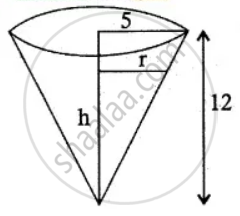Advertisements
Advertisements
Question
A conical water tank with vertex down of 12 metres height has a radius of 5 metres at the top. If water flows into the tank at a rate 10 cubic m/min, how fast is the depth of the water increases when the water is 8 metres deep?
Solution

From the figure `"r"/"h" = 5/12`
r = `(5"h")/12`
Given rate of change of volume `"dV"/"dt"` = 10
When h = 8 to find `"dh"/"dt"`
Volume of cone V = `1/3 pi"r"^2"h"`
V = `pi/3((5"h")/12)^2"h"`
V = `pi/3((25"h"^3)/144)`
= `(25pi)/432 "h"^3`
DIfferentiating w.r.t. 't'
`"dV"/"dt" = (25pi)/432 (3"h")^2 "dh"/"dt"`
10 = `(25pi)/432 (3(8)^2) "dh"/"dt"` ......[∵ Given h = 8]
∴ `"dh"/"dt" = 1/pi (432 xx 10)/(3 xx 25 xx 64)`
= `4320/(4800pi)`
= `0.9/pi`
= 9/(10pi)`
The depth of the water increasing at the rate of `9/(10pi)` m/min
APPEARS IN
RELATED QUESTIONS
A camera is accidentally knocked off an edge of a cliff 400 ft high. The camera falls a distance of s = 16t2 in t seconds. How long does the camera fall before it hits the ground?
A camera is accidentally knocked off an edge of a cliff 400 ft high. The camera falls a distance of s = 16t2 in t seconds. What is the average velocity with which the camera falls during the last 2 seconds?
A particle moves along a line according to the law s(t) = 2t3 – 9t2 + 12t – 4, where t ≥ 0. Find the total distance travelled by the particle in the first 4 seconds
A particle moves along a line according to the law s(t) = 2t3 – 9t2 + 12t – 4, where t ≥ 0. Find the particle’s acceleration each time the velocity is zero
If the volume of a cube of side length x is v = x3. Find the rate of change of the volume with respect to x when x = 5 units
If the mass m(x) (in kilograms) of a thin rod of length x (in metres) is given by, m(x) = `sqrt(3x)` then what is the rate of change of mass with respect to the length when it is x = 3 and x = 27 metres
A stone is dropped into a pond causing ripples in the form of concentric circles. The radius r of the outer ripple is increasing at a constant rate at 2 cm per second. When the radius is 5 cm find the rate of changing of the total area of the disturbed water?
A ladder 17 metre long is leaning against the wall. The base of the ladder is pulled away from the wall at a rate of 5 m/s. When the base of the ladder is 8 metres from the wall. How fast is the top of the ladder moving down the wall?
A ladder 17 metre long is leaning against the wall. The base of the ladder is pulled away from the wall at a rate of 5 m/s. When the base of the ladder is 8 metres from the wall, at what rate, the area of the triangle formed by the ladder, wall, and the floor, is changing?
Find the slope of the tangent to the following curves at the respective given points.
x = a cos3t, y = b sin3t at t = `pi/2`
Find the tangent and normal to the following curves at the given points on the curve
y = x4 + 2ex at (0, 2)
Find the tangent and normal to the following curves at the given points on the curve
x = cos t, y = 2 sin2t at t = `pi/2`
Find the equations of the tangents to the curve y = `- (x + 1)/(x - 1)` which are parallel to the line x + 2y = 6
Find the equation of tangent and normal to the curve given by x – 7 cos t andy = 2 sin t, t ∈ R at any point on the curve
Find the angle between the rectangular hyperbola xy = 2 and the parabola x2 + 4y = 0
Choose the correct alternative:
The position of a particle moving along a horizontal line of any time t is given by s(t) = 3t2 – 2t – 8. The time at which the particle is at rest is
Choose the correct alternative:
Find the point on the curve 6y = x3 + 2 at which y-coordinate changes 8 times as fast as x-coordinate is
Choose the correct alternative:
The slope of the line normal to the curve f(x) = 2 cos 4x at x = `pi/12` is
Choose the correct alternative:
The tangent to the curve y2 – xy + 9 = 0 is vertical when
Choose the correct alternative:
Angle between y2 = x and x2 = y at the origin is
